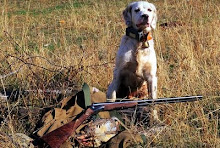 |
| Berg Brothers Head Turner |
Scott Berg, of Berg Brothers Setters, has this to say on the subject of line breeding...
"In terms of what is an acceptable level of inbreeding, opinions are going to vary. There is considerable empirical evidence that supports the position above that COI levels well into the 20s can be sustained. Personally, I don’t find it necessary to push those limits. However, the difference between .03 or even .06 and .25 is very wide and the practical implications are very substantial. The practical implications would be that we would have to focus on diversity not performance to maintain levels at .03 or below. This approach suggests that breeders have done such a good and consistent job in selection that the consistency we seek in narrowing the gene pool for a specific breeding is already present in the population. This is a very uninformed position in my opinion. For starters, 95% of breeders don’t evaluate and cut enough prospects to gain anywhere near this level of consistency. There are substantial differences in size, build, gait, stamina, heat tolerance, intelligence, biddability, mental make-up, bird finding, manners around game and the traits that make for good companions.
We have always followed a pretty basic premise which is to put a significant number of prospects through a rigid selection process and only retain the superior individuals. We have experimented with a large percentage of the available ES lines and have evaluated about 250 individuals of my own for breeding purposes. That number is probably low because we have evaluated 90+ in the past 3 years. Of course, we also get substantial feedback from clients, and we have trained, trialed with and observed a thousand (literally) other dogs. Our experience would suggest line breeding produces a significant but not monumental increase consistency and the overall quality of the individuals produced. We will continue to breed the best individuals and monitor our relative success.
Line breeding is not very practical for the guy with 4-6 dogs in the backyard. Actually, I think that is a considerable factor in this method being questioned. That’s how guys that breed 1-2 litters/year constructs a position that their methods and understanding rival Bob Wehle. I break par a few times a year but I sure as hell am not going to compare my knowledge of the golf swing to Butch Harmon.
The relative benefit of line breeding is a constructive topic. I believe that good dogs can be produced in a heterogeneous litter as long as the ancestry consists of exceptional individuals throughout the pedigree. We have produced many such litters. However, our observations have been that modest inbreeding (half-sibs or less) produces with greater consistency. This pattern will produce COIs well below what has PROVEN to be tolerable levels."








No comments:
Post a Comment